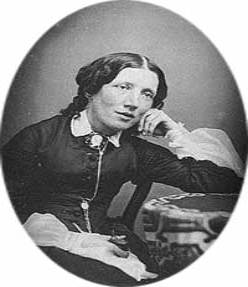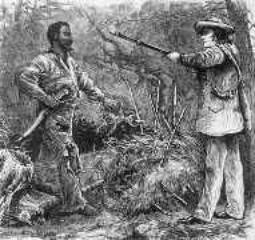
Sample Student Research Project, fall 2004
LITR
4232: American Renaissance

Sample Student Research Project, fall 2004
Student: Audra Caldwell
Assignment: American Renaissance Journal
Date: 11-15-04
History
and Authors of Slave Narratives
Such a taboo topic as Slavery is often romanticized or glossed over in many literary works and history texts, but none the less, no one can argue that it was not a significant issue in American history and its developing future. Unless it is a particular interest to an individual to hunt out the truth, the terrible life that slaves faced daily is not normally revealed, however; through the few slave narratives written during the American Renaissance literary era, the raw truth about these slaves and their lives can be found along with the significance the writers have had in the area of literature. Along with this era of slavery followed the era of abolition. Again slave narratives played a significant role in forming hope and truth for the black community. A few of these significant writers are Harriet Beecher Stowe, Fredrick Douglass, and Nat Turner.
Harriet
Beecher Stowe
(1811-1896)
The Life of…

Harriet Beecher Stowe can be labeled as one of the most influential writers in the time of slavery and abolition. She came from a family that was extremely active in the abolition movement and spoke there message from the pulpit. Stowe’s family consisted of 8 ministers, seven of them her brothers and the last her father, and sisters; whom where also eventually very active and outspoken for women of their time. Harriet Beecher married Calvin Stowe in , but at this time did not have much to show for her later passion of abolition. Harriet’s first work Uncle Tom’s Cabin was written in 1852, and turned to be her most famous and influential work. Stowe went on to write many more literary works and to be a highly influential part of the abolition movement. Stowe worked with her passion until the day she passed in 1896.
Uncle
Tom’s Cabin
As stated previously, Uncle Tom’s Cabin was Harriet Beecher Stowe’s first, most famous and most influential work dealing with the abolition of slavery. The fictional writing steeped from the interaction Harriet Beecher Stowe had with run away slaves and the personal observation she dealt with while living in Ohio. The now novel was published in weekly by chapter in Fredrick Douglass’s North Star [newspaper]. Uncle Tom’s Cabin is a story of Tom, a God-fearing slave, who struggles to gain freedom legally from his master by obeying, leading and finally dieing because of maltreatment. A side story is also present in Uncle Tom’s Cabin. This story is of a slave named Eliza. She is also struggling to gain her freedom, but when put in a desperate situation runs with her young son and reaches her goal by reuniting with her husband and crossing the northern border. Neither character reaches their goal easily. They are all faced with many trials, struggles, and moral dilemmas. Stowe uses these dilemmas to appeal to the ethos of a broad audience and draw them into loving and relating with the slave characters; and in turn to support the abolition of slavery. At the time her mission was to gain support, but over the last 150 years the inspiration and extreme sense of purity has turned the book into a great classic among literary work.
Although this is a fictional work, it is still considered a slave narrative because its message is so true and factual to the events of the time.
Fredrick
Douglass
(1818-1895)

The Life of...
Fredrick Douglass had a much different life than Harriet Beecher Stowe. Douglass was born into slavery, from a black mother and a white father. He spent his childhood with his grandmother, hardly seeing his mother at all and not being sure who his father even was. Douglass had a belief that education was his key to freedom, and started learning to read and spell at a young age from his master’s wife, Mrs. Auld. Mrs. Auld was soon stopped from teaching young Douglass, but this did not suppress his want to learn. Eventually Douglass became extremely literate by using any sort of material he could obtain. Douglass reached his goal of freedom by running to New York. There Douglass’s passion of freedom and equality drove him to become on of the most prominent black leaders and speakers of the abolition and women’s rights movement. Douglass’s literary history began with his newspapers, “the North Star”, “Fredrick Douglass Weekly”, “Fredrick Douglass Paper”, “Douglass Monthly”, and the “New National Era”. However, Douglass’s most famous literary work was his Autobiography, Narrative of the Life of Fredrick Douglass (1845). Douglass continued his fight in support of equality for all until he died of a massive heart attack at the age of 78.
Narrative
of the Life of Fredrick Douglass
Fredrick Douglass wrote this slave narrative of his life at the age of 28. Douglass’s narrative was published and obtained a great amount of criticism from readers claiming that, “no black man could not have written this”. In his biography, Douglass is eloquent, educated, and realistic. This true and detailed depiction of Douglass’s life from a literary standpoint upholds a high bar for future slave narratives and the view of all blacks during the time of abolition. The idea of a slave rising against the act of slavery and reaching his goals through the use of education put him in a very powerful position as an advocate and speaker.
Nat
Turner
(1800-1831)
The Life of…
 Like
Douglass, Nat turner was also born a slave. His mother was an original African
slave and taught Nat at a very young age to detest slavery. Nat believed that
God had chosen him to lead his people out of slavery; and after being taught to
read by his master’s son, Turner gained knowledge quickly and used it greatly
to the advantage of these deep religious beliefs. Nat was also believed to be a
sort of genius; once his mother overheard him telling other children a
recollection of an event that happened while he was still in his mother’s
womb. These sort of events lead him to eventually be referred to as “the
prophet”. Nat was a minister to other slaves and eventually felt his calling
had been reached. Turner led a group of fellow slaves on a massacre known as the
Southampton Slave Revolt. During this revolt 55 whites were killed by murder,
and the judiciary events that followed hung/killed 200 blacks, including Turner
himself. Before his death, Turner revealed all the details of his life and of
the rebellion to Thomas R. Gray who published Nat Turner confessions in 1831, The
Confessions of Nat Turner.
Like
Douglass, Nat turner was also born a slave. His mother was an original African
slave and taught Nat at a very young age to detest slavery. Nat believed that
God had chosen him to lead his people out of slavery; and after being taught to
read by his master’s son, Turner gained knowledge quickly and used it greatly
to the advantage of these deep religious beliefs. Nat was also believed to be a
sort of genius; once his mother overheard him telling other children a
recollection of an event that happened while he was still in his mother’s
womb. These sort of events lead him to eventually be referred to as “the
prophet”. Nat was a minister to other slaves and eventually felt his calling
had been reached. Turner led a group of fellow slaves on a massacre known as the
Southampton Slave Revolt. During this revolt 55 whites were killed by murder,
and the judiciary events that followed hung/killed 200 blacks, including Turner
himself. Before his death, Turner revealed all the details of his life and of
the rebellion to Thomas R. Gray who published Nat Turner confessions in 1831, The
Confessions of Nat Turner.
The
Confessions of Nat Turner (1831)
Although this literary work was not written by Turner himself does not lessen the impact it has had on America’s outlook on slavery and historical events. The words give insight to religion, family bonds, and horrors of the time from a slave’s point of view. This Confession revealed so much information that it caused slave owners and slavery supporters to begin to fear slaves. One incident mentioned in the Confessions that gives insight to his character and impact on slave rebellion was the 70 or so fellow slaves that followed “the prophet” into a revolt murdering many. Ultimately the Confessions given by Nat Turner and published after his punishment provide inside knowledge of the revolt and later revolts in American Renaissance history and knowledge of driving forces of black slaves, which also led to further literary works on the subject of slavery by slaves.
References
Fredrick Douglass” The Free Dictionary. Online.
http://encyclopedia.thefreedictionary.com/Frederick%30Douglass. Nov. 9, 04.
French, Scott. The Rebellious Slave-Nat Turner in American Memory.
New York: Houghton Mifflin Co, 2003.
Goldman, Steve. “The Southampton Slave Revolt” History Buff. Online.
www.historybuff.com/library/refslave Nov. 11, 04.
Lauter, Paul. The Heath Anthology of American Literature. 4th ed.
Boston: Houghton Mifflin Co, 2002.
McKissack, Pat. McKissack, Fredrick. McKissack, Patricia. Frederick
Douglass: Leader Against Slavery
(Great African Americans
Series). Revised ed. Enslows, 2002.
“Nat Turner” Online. http://www.spartacus.schoolnet.co.uk Nov. 9, 04.
Public Broadcasting Systems Online.
“Judgment Day” Africans in
America. Online. www.pbs.org/wgbh/aia/part4/4narr2.html.
Nov. 11, 04.